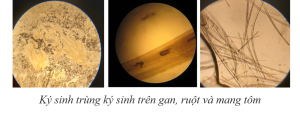Good stock is the beginning of success. It is difficult to avoid shrimp diseases in the shrimp farming process. However, there is an idiom that prevention is better than cure. Therefore, getting the types and symptoms of diseases will help farmers know about effective disease prevention, especially Gregarine disease on farmed shrimp.
In recent years, industrial shrimp farming has been expanded, increasing productivity and production. However, it also faces many challenges such as unstable prices, and diseases, especially intestinal diseases. There are many pathogens that cause disease, but the most concern is Gregarine.
What is Gregarine?
Gregarine is a group of parasitic protozoa. They are intermediate parasites on bivalve mollusks and polychaete worms. This one enters the shrimp’s body when they attach to the gills or are ingested by the shrimp. They attach to the intestinal wall of shrimp, causing intestinal damage and obstruction, especially harm to the intestinal mucosa. It creates an opportunity for harmful bacteria to enter and cause many diseases on shrimp, most commonly white feces disease. The disease usually occurs when shrimp are at 40-50 days old or more. Although this disease is not as dangerous as white spot and yellow head disease, it can spread quickly, causing reduced productivity and heavy losses to shrimp farmers.

Gregarine on the liver, intestines, and gills of shrimp
- Symptoms:
In shrimp infected with parasites in the first stage, the shrimp’s intestines curl in a Z shape. After that, it will break and have milky white. Besides, shrimp also reduce eating.
After 7-10 days of infection, shrimp intestines will be yellow and milky white. The intestinal tract near the tail is swollen, round, or rice-shaped. If Gregarine enters the liver, it will cause the shrimp liver to discolor, atrophy, and then yellow liver disease.
Finally, the shrimp curled up their body, swam on the surface, edged off the ponds, and died.
To accurately identify the disease, we should see the shrimp sample under the microscope.

Gregarine on the liver and intestines of shrimp
Preventive measures:
- Choosing reputable and quality postlarvae hatcheries.
- Renovating the pond carefully and according to the technical process.
- Stocking with the appropriate density, season, and weather.
- Limiting intermediate hosts such as crabs and crustaceans by biosafety products.
- Periodically killing parasites with products such as BKC, IODINE, and herbal medicines.
- Mixing sulfamides into the feed. For treatment, feed for 3 consecutive days, periodically 2 days/time. For disease prevention, feed for 1 time/day, periodically 7 days/time.

 Tiếng Việt
Tiếng Việt 中文 (中国)
中文 (中国)